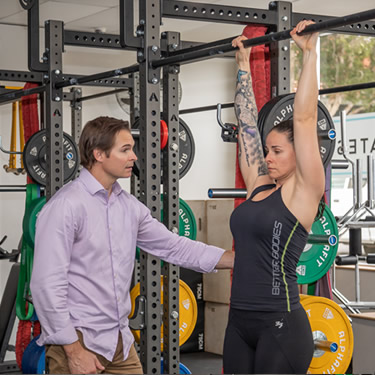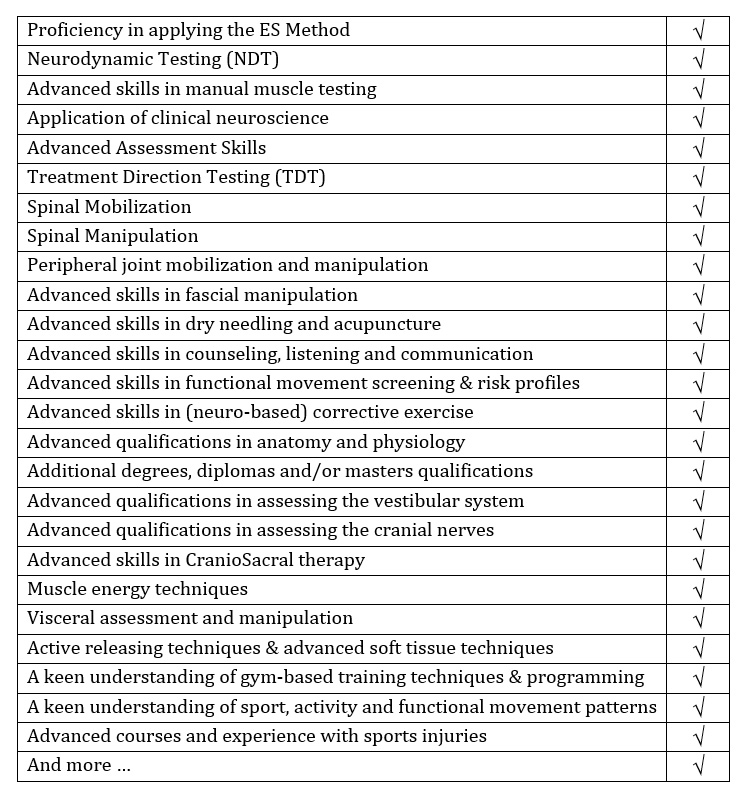Following on from Part 1 – A new health care model (holistic healing), we’ll now look deeper into what sets our practitioners apart before detailing more about physiotherapy in the last two blogs of the series. Find out more about what we can do for you and your health!
What is the definition of an Effortless Superhuman (ES) Pain & Dysfunction Practitioner?

- A keen understanding of the (ES) Method and its application
- A holistic view of health and wellness: Mental, spiritual, social/emotional, and physical health
- A keen understanding of the (ES) Performance Pyramid and its clinical application to health and wellness and high performance.
- A growth mindset
- An optimistic explanatory style
- The ability to recognize their specific role as part of a multi-disciplinary (integrated) team of health professionals.
- The ability to integrate the best skills, knowledge and methodology from a wide range of disciplines for the benefit of their clients. Osteopathy, physiotherapy, chiropractic, TCM, massage therapy, movement practitioners, naturopathy, holistic lifestyle coaches, functional medicine/nutrition, and more.
- A keen understanding of the (ES) ‘Cause’ and ‘Mission Statement.’ An understanding of how their role at (ES) and within the community will help to create a happier, healthier future for everyone.
Pain & Dysfunction Practitioners
Effortless Superhuman (ES) Grading System
Effortless Superhuman has taken the unique step of creating an internal grading system for its Pain and Dysfunction practitioners. There are several key reasons why this initiative was taken:
- To provide a structured career path that is in the best interests of the practitioner, the clients and Effortless Superhuman
- To map out the practitioner journey with respects to ongoing education and its application to enhanced client outcomes.
- To allow clients to gain a precise understanding of the competency of each (ES) practitioner. Clients can have the confidence that the higher the practitioners grading, the greater their skill set and experience, and the greater is their ability to handle complex issues.
- As a form of internal ‘triage’ that allows ES practitioners to handle clients that are appropriate for their skill set and experience. More complex clients will be booked to see more experienced practitioners (higher grading). If a ES practitioner is not making consistent progress with a client they can refer that client to a practitioner with a higher grading for further evaluation.
- ES practitioners with higher grading charge a higher value per consultation. More experienced practitioners will consult less hours per week allowing them more time and energy to focus on more complex cases. This is of benefit to the client, the practitioner and Effortless Superhuman as a business. This simple concept has been demonstrated to significantly enhance clinical outcomes by consistently achieving the clients’ “Good Outcome.”
- Clients with pain or dysfunction that are deemed to be ‘straight-forward’ can be moved from a more experienced practitioner to a practitioner with a lower grading. This will save the client a significant amount of money.

In order to move up a grading level at (ES), the practitioner must satisfy the selection criteria:
1. The required number of years of clinical (industry) experience. This reflects the minimum number of years of full-time practice needed to qualify for that level. In most cases the ES practitioner has completed more years of experience than is required.
2. (ES) hours is the minimum number of hours worked at Effortless Superhuman. (ES) practitioners are expected to accomplish a wide range of advanced ‘Learnings’ that are unique to (ES).
- Specific books to read
- Specific DVDs and documentaries to watch
- Specific courses that must be completed
- A specific number of hours spent upskilling themselves with other practitioners (inside ES and at other practices)
- And more …
As a multi-disciplinary Institute, our pain and dysfunction practitioners are required to obtain advanced skills and knowledge that may be considered outside their normal scope of practice. This includes:
- Holistic Lifestyle Coaching
- Advanced courses and a keen understanding of health and nutrition
- Advanced courses in Functional Diagnostic Nutrition or Functional Medicine.
- Advanced courses in counseling, listening and communication
- Advanced courses in functional risk assessments and athletic screening.
- And more …
3. A comprehensive syllabus has been created for every (ES) level in the grading system. This syllabus is unique to (ES) and provides a precise ‘career journey’ for each (ES) practitioner. To the best of our knowledge, this is the most comprehensive and demanding protocol of any facility in the world.
Although our practitioners may have qualifications as a Physiotherapist, Chiropractor or Osteopath, they are expected to develop competencies in all of these disciplines.
Chiropractor Physiotherapist Osteopath
Our most experienced practitioners will have obtained competency in all of the following areas:

Click here for Part 3, where we’ll look into the key concepts that our practitioners follow and explore the history of physiotherapy, its methodology and the research that backs it.
To book an appointment with an ES practitioner please call (08) 9388 2768.
